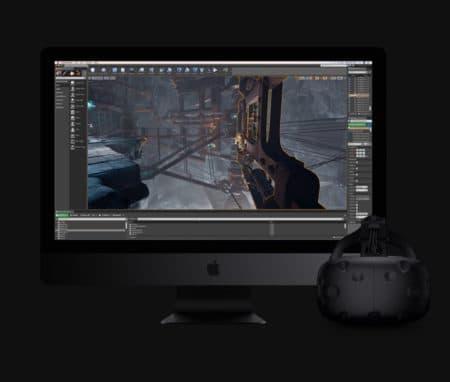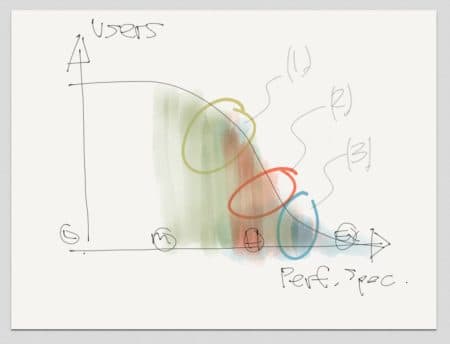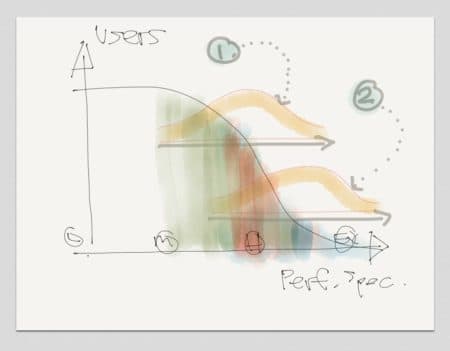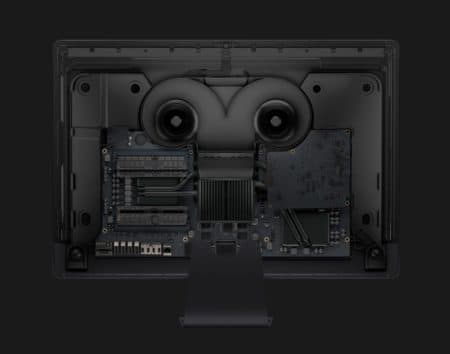Earlier this week Apple likely surprised many with its half-dozen announcements at its 2017 WWDC. It was really a phenomenal display of new gear. Of all the new items, to Architosh readers the new iMac Pro and the new support for both AR and VR in Apple devices surely delights.
In this article, we want to focus on the new iMac Pro—coming this December.
New iMac Pro
In our original 2014 article, titled, “Breaking the Jobsian Quadrant: Should Apple Make an iMac Pro,” we answered the question about why Apple needed to break Steve Jobs’ neat four-quadrant product matrix by making an iMac Pro by saying this:
The short answer is because it needed to. The long answer is because putting computers and devices into neat little quadrants with absolute “user-type” boundaries creates arbitrary usability barriers which are simply not practical.
That statement was backed up by our Mac Pro workstation survey research, but Apple eventually realized this too and in its recent confessional press discussions about the new Mac Pro—the one coming up in 2018—the company admitted that the iMac was an extremely popular machine with a certain segment of professional users.

01 – Apple’s new iMac Pro will set new performance boundaries for an all-in one computer. It will also satisfy many pro user’s needs. (image credit: Apple.)
So the good news this week is Apple seems to be deadly serious about its Mac professionals, judging by what they threw at the new iMac updates and what they are packing into the new iMac Pro.
What Does the Word “Pro” Mean Anyway?
One of the things that came out when Apple released the ill-fated 2013 Mac Pro was this notion that Apple didn’t really understand what “pro” meant any longer. (see, Architosh, “Viewpoint: Mac Pro, What Does Apple Mean by Pro? A View from a Professional in 3D, Animation, VFX and Video Games,” 17 Feb 2014)
In the viewpoint piece, veteran 3D industry professional Akiko Ashley noted that “it is said that the two main industries that push technology to its edge are the military and the motion picture industry.” One might jump to the conclusion that the new iMac Pro—given its form factor—isn’t meant for either of those industries. That would be partially false. It would also be partially false that the new iMac Pro is the type of machine that fits the bill perfectly for both general and specialized CAD professionals.
MORE: Apples Does the Unexpected—Announces New Modular Mac Pro Design Underway
The truth is the new iMac Pro can definitely have a place in both the military and the motion picture industry. Those industries push the limits of technology, but that doesn’t mean every seat in those industries needs to. Likewise, the new iMac Pro is ideal for most CAD professionals, but some CAD professionals do run apps that push at the edges of performance that only Apple’s upcoming modular Mac Pro can likely accommodate.
Pro Definition With Respect to Performance Spectrums vs Audience
“Pros” for Apple consists of classic Apple creatives as well as technical design, engineering, and science (TDES) professionals. TDES professionals include engineers, scientists, programmers, and architects.
It is this swath of professionals that Architosh is most familiar through our own research. Our research and industry knowledge tells us that each TDES industry segment consists of users with varied computer performance requirements.
In our free-hand chart below, the X-axis indicates performance spec requirements ranging from low (L), medium (M), high (H) to extremely high (EX). When Ms. Ashley notes that the motion picture and military industries push tech to the extreme, it means they have many users in the EX category.

02 – This chart shows a conceptual view of how Apple’s Mac users fit relative to cutting edge, extreme (EX) computing performance. Colors equal: green (CAD pros); red (film-VFX pros); blue (engineering/science pros).
Regardless of industry—militiary or otherwise—the percentage of users who are EX category users is relatively low compared to the average Mac or PC user’s performance spec. requirements. (see image 02) But as the performance backs down from extremely high to just high (H category) the users goes up sharply. This is the sweet spot for the iMac Pro in many cases.
Pro Definition by Expandability (I/O) and Parallelization
The Pro definition needs to be liberated from the notion of seeing the “pro” user as this mechanically inclined person who wants to hot-rod out his machine with add-ons and gear. This is not 1978 anymore.
Some users, whether in creative industries or TDES industries need (or desire) to remove, replace, add and alter physical hardware components over time. In general, it is the back-end of TDES pros—the engineers and scientists—and many production pipeline users in film and music who need this requirement. These folks have advanced expandability and I/O (input/output) needs.
In our survey research, we found that scientists—the kind in national labs and the kind in medical research settings—often acquire machines that have more than 32 CPU cores and multitudes of GPUs in parallel. Parallelization—in their software—is the main driver of these requirements. The same goes for production pipelines at places like Pixar.

03 – This chart conceptualizes overlapping machine use groups (1) and (2), respectively iMac Pro versus 2018/19 Mac Pro.
In the chart above we can conceptualize two machine user groups. Group 1 users buy the new iMac Pro. Group 2 users buy the upcoming new modular Mac Pro. It is the purpose of the future Mac Pro to deliver a machine that can essentially (or nearly) reach the limits of computer performance in a workstation. It will achieve that through extreme parallelization.
The bell-shaped curve (golden) for Group 1 indicates that there may be a fairly standard even distribution around the metric of CPU cores. Since Apple has limited the regular new iMac to four core Intel i7 CPUs, users seeking machines ideal for highly threaded apps will seek out the iMac Pro, starting with 8 cores.
The lower curve is for the new future Mac Pro modular workstation. That curve overlaps all three industry domains (shaded from green, to red, to blue) but runs to the EX category user and many buyers of such a future machine will acquire it for its extreme parallelization workflows. Today’s leading-edge PC workstations can deliver up to dual 22-core Xeons for a whopping 44 core machine. And they can pack four (4) double-width leading-edge GPU cards.

04 – The rear of the new iMac Pro shows how Apple packed in new thermal heat dissipation technology in the exact same form-factor of the matching regular iMac. (image credit: Apple)
The new iMac range once the Pro version ships will take that form factor from 4 to 18 cores. This means support machines in national labs can run the gamut from single-threaded workflows to high parallelization up to 18 cores on a simple form-factor unit.
Closing Thoughts—Future Mac Pro
Some folks think it’s silly for an iMac to have 18 cores. The faulty thinking here is based on correlating all parallelization with expandability and IO needs. Many folks just need the cores and parallel performance and don’t need much else. As the chart shows above (image 03) the new iMac Pro can serve both creatives who want bleeding edge performance in a simple appliance like form-factor, while also meeting the needs of more complex TDES (technical design, engineering, and science) pros.
So who will need the new modular Mac Pro?
Many will not. But for those who do: any kind of creative or TDES pro who wants to “future proof” their buy and will pay a bit extra for that flexibility. Or, any kind of pro who demands expandability and larger I/O capabilities that are beyond the iMac form factor. But most importantly, Mac pros who need competitive workstations for highly parallel workflows and need to reach the EX category of performance.
This final note just means one thing: Apple you must be thinking dual Xeons in the future Mac Pro.



Reader Comments
Amped dual i9s and maxed out dual AMD radeons will be the start point for a truly bodacious machine.
Amped dual i9s and maxed out dual AMD radeons will be the start point for a truly bodacious machine.
reddinghistoricalsociety, I’m glad you mentioned the Intel Core i9’s…that is a chip many forget to think about—including me—when contemplating new workstation Macs. There is definitely a case for Apple to make a “modular” Mac Pro that is modular enough to work with both Xeons and i7’s and i9’s for single-threaded apps at high frequency speeds. Thanks for the excellent remark.
reddinghistoricalsociety, I’m glad you mentioned the Intel Core i9’s…that is a chip many forget to think about—including me—when contemplating new workstation Macs. There is definitely a case for Apple to make a “modular” Mac Pro that is modular enough to work with both Xeons and i7’s and i9’s for single-threaded apps at high frequency speeds. Thanks for the excellent remark.
Comments are closed.